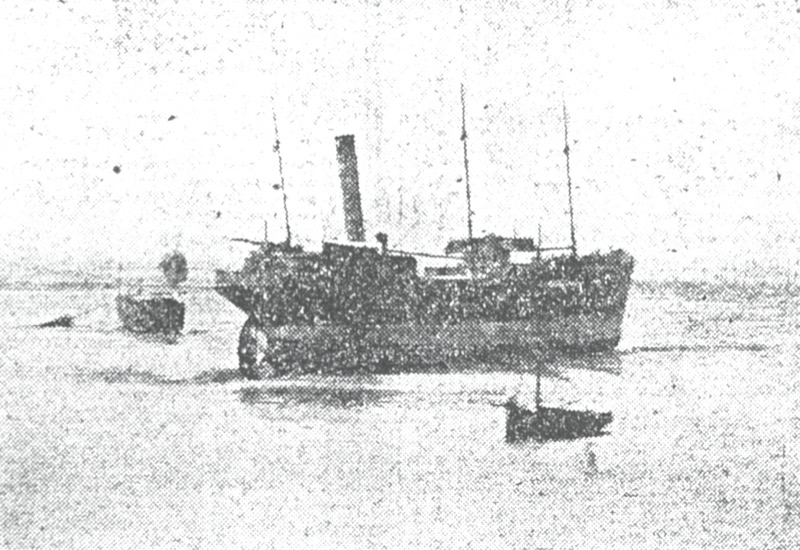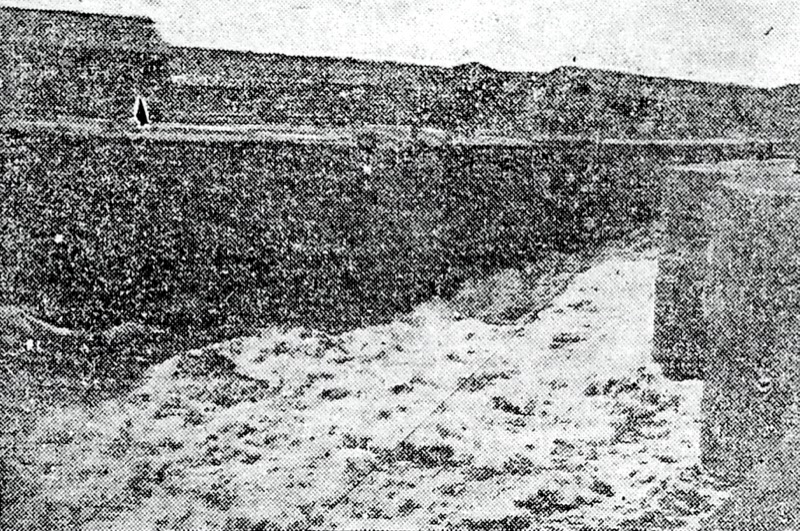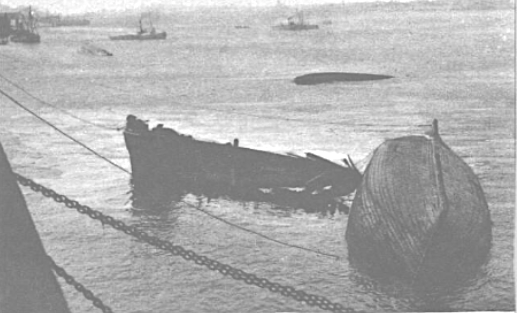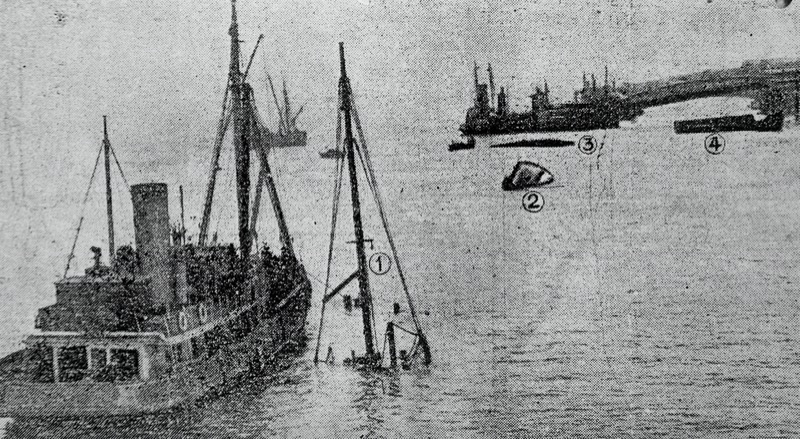

SS Countess, heading on 5th June 1920 from the Alfred Dock, Birkenhead, into the lock, struck the outer lock gates and smashed them. The resulting avalanche of water swept the Countess out into the Mersey, along with 18 smaller vessels: flats and barges. Many of the flats were sunk, some were split in two. It took several days to find and remove the sunken wrecks. Mercifully, there was no loss of life in this disaster.
Not all the flats and barges are listed in MNL - possibly because they traded only within the Mersey and adjoining canals - so were not considered as "sea-going". With so many wrecks, details are not always well documented, but several vessels cease to be listed after 1920, so were presumably scrapped after being lifted. The traditional flat was a sailing vessel, but, by 1920, many were dis-masted and used as dumb barges, to be towed by steam vessels. Several of the larger barges had previously been iron steam paddle tugs [Sunshine - ex-Alliance; Rufford - ex-Flying Cloud; W S Patterson - ex-Vigilant], but were converted to dumb barges. Two had been ocean-going sailing vessels that were dismasted and turned into "hulks". The list of wrecked vessels provides a good insight into the importance of flats and barges in transporting cargo and coal to and from larger vessels. Many were taking Welsh steam coal to liners in the river. Several were carrying grain instead.
The cause of the mishap: SS Countess (beached) and the torrent of water.


Aftermath: Images of wrecked flats outside the Alfred Dock:


Liverpool Journal of Commerce - Monday 07 June 1920
BIRKENHEAD DOCK DISASTER.
MANY CRAFT SUNK THROUGH BURSTING OF DOCK GATES.
An extraordinary disaster occurred in Alfred Dock, Birkenhead, on
Saturday at the time of mid-day tide. The steamer Countess,
outward, light, entering the thirty feet lock, struck the gates,
causing them to burst open. The water in the dock being fifteen feet
above that of the river caused a huge outrush of water, which carried the Countess and
several barges out into the river. The number of barges involved is
believed to be sixteen, fifteen of which have been identified, four of them in pieces.
The steamer, which was holed, was taken in tow and placed on Tranmere
Beach, as also were the flats Obadiah, Ida, Edward Wheatley, James
Wilson and Pirate. The following are amongst those sunk - Sunshine,
Rufford, W. S. Patterson (loaded wheat], America, Francis, Annie,
Cedron and Vernon[sic]. With regard to the steamers in dock, it is reported
all kept afloat, and no damage is anticipated in this respect.
Although it is believed there is no loss of life, the authorities are
assaying to trace the identity of occupants of the many craft capsized
by the tremendous avalanche of water.
An eye-witness described the rush of
water into the river, following the bursting of the lock-gate, as a
20 feet high avalanche, which I carried everything before it. A
survivor stated that the first moments of the disaster were agonising.
Tiny boats and dozens of men were tossing on the crest of the
Niagara, and plunged into a regular whirlpool beneath. The crews of
the boats were powerless to move, and hung on to the sides of their
craft while being swept along at a terrific rate by the force of the
onrushing water.
Runcorn Weekly News - Friday 11 June 1920
MERSEY DISASTER. THREE WIDNES BARGES SUNK.
MIRACULOUS ESCAPE OF WIDNES, RUNCORN AND GARSTON MEN.
WIDNES CAPTAIN'S NARRATIVE OF THRILLING EXPERIENCES.
Three Widnes barges, belonging to Messrs. Wm.
Cooper and Sons. were involved in the extraordinary disaster that
occurred on Saturday morning at Birkenhead. They are the Pirate, the
William, and the Leila. One was beached in Tranmere Bay; another
has been located in the river not far away from the scene of
disaster, lying bottom upwards; and the third was found on Tuesday and
beached. Happily there was no loss of life, though a number of men
from Widnes, Runcorn and Garston were aboard one or other of the score
of barges swept out of the Alfred Dock into the river when the dock
gates were burst, releasing an enormous volume of water which swept
everything before it through the 30 feet lock entrance.
WIDNES CAPTAIN'S THRILLING EXPERIENCES. In an interview with a "Weekly
News" representative, Mr. Sam Hatton, the captain of the Leila, one of
the ill-fated Widnes barges, gave his impressions of the disaster.
"Our flats." he said, "were laden with coal waiting on the dock side
of the gates with other flats ready to go out in the river, when the
lock was opened. I was in charge of the Leila, laden with 150 tons of
Welsh steam coal, and my mate was F. Randles. My brother, Nathan, was
captain of the William, and his mate was Jimmy Atherton, of Farnworth.
She had aboard 120 tons of coal. The Pirate, laden with 150 tons of
coal, was in charge of George Wharton, his mate being J. Kenwright,
of Runcorn. We were all on deck at the time, fortunately. I saw the
Countess coming and it looked as if there would be a smash. When the
gates went we knew that the flats would be carried through the lock,
and we jumped for it. It was a jump of three or four feet, but we all
managed to scramble on to the quayside. Then we saw the boats go one
by one. It was a sheer drop of 12 or 15 feet, and it was a sight I
don't want to see again. I can tell you I was quite unnerved yesterday
(Sunday) as I thought of the narrow escape we all had. There was my
brother and myself, and you know we lost another brother not long ago
in the river." "That was when your father was aboard another flat near
by and saw your brother washed overboard?" queried the "Weekly News"
man. The answer was in the affirmative. "Your father was not aboard any of
the flats on Saturday?" "No" answered Sam. "He is on one of those flats sailing down
the river, now," pointing along the fairway in the direction of
Liverpool as he replied.
Asked to continue his narrative, the Leila's captain
said "The first of our boats to go over was the Pirate. She dived
right down like a swimmer and came up some distance away like a whale,
and then sank. The same thing happened with the William. Our boat,
the Leila, went down bow first, and she turned right over, her stern
coming up into the air as she turned. She has disappeared altogether.
It was an awful sight, the water rushing through the lock and carrying
all before it. You may know how much water came down when I tell you
that it raced away for an hour and three-quarters before it levelled
itself. In that time the rising tide would lift, probably, ten feet,
so that the difference was really only five feet at the end. We have
since found the William lying bottom upwards on top of another boat
just outside the dock, while the Pirate floated and has been beached
in Tranmere Bay. We are going out to-day (Monday) with tackle to try
and lift these boats and bring them home."
GARSTON CAPTAIN'S PRESENCE OF MIND. Captain Samuel Ireland, of Shrewsbury road, Garston, who was
in command of the Sunshine, the largest of the barges involved, has
earned the deep gratitude of all the men connected with the barges,
who emphatically declare that they owe their safety to the action he
took. Captain Ireland happened to be on the quayside at the time. He
was waiting there to pilot his vessel out of the dock, his son,
William, the mate of the barge, and an extra hand being aboard. Seeing
the Countess coming towards the gate, Captain Ireland thought that the ship
was trying to nip in to get first turn when the lock gates opened. He
was naturally curious, and this caused him to watch more carefully the
progress of the steamer. As she did not slow down, and was making
straight for the gate, he felt instinctively that an accident would
occur, and at once yelled out to the men on the barges to jump
ashore. They were all pals together, the men on the ten or a dozen
barges tied up by the dock wall, and one or two of them sang out that
he had gone mad. However, they promptly answered the call and
scrambled ashore. He afterwards directed much of the rescue work, and
later on, realising the possibility of the island on which the men had
taken refuge giving way before the torrent of water, he urged them to
cross over the 50-ft. bridge, which was holding up the water on the
one side, to more solid ground. Captain Ireland was warmly
complimented on his presence of mind.
Birkenhead News - Wednesday 09 June 1920
THE SALVAGE WORK. On Monday it was officially stated that seventeen [later increased to 18]
small craft were involved in the calamity. Salvage work has been
proceeding since Saturday, and two days ago the raising of the
steam-barge Sunshine from the 100-foot fairway cleared the entrance
to the dock. The dock gates into which the Countess crashed have
completely disappeared, and ebb-tides, and the work of divers have
revealed the extraordinary predicaments of some of the sunken barges.
One of them was found with her bow firmly wedged in the hatch of
another. This was the Annie; her name is just visible at low water;
she had nose-dived into the other barge just outside the entrance to
the dock. Along the river wall, towards the Wallasey cattle stage,
are the remains of a barge which seems to have been dissected by
another lying bottom upwards across her. Pieces of wreckage have been
found five miles from the scene of the disaster, and barges have been
identified by the finding of portions of their sterns bearing their
names, but completely separated from the vessels. This has led to the
location of the remaining portions below the water. The stern portion of
the Edward Hutchinson lay for some time behind the Woodside stage; it
has now been raised, but the remainder of the hull has not yet been
found. Salvage operations in connection with the Countess, beached at
Tranmere with a number of barges, were in progress yesterday.
The Underwriters' Association report that the flats beached at Tranmere
had on board the following loads:- Pirate 150 tons coal; Edward Whitley, 61
tons flour; William, 120 tons coal; Edward Hutchinson, 85 tons wheat;
Glenogle[sic], 260 tons coal; and Leila, 150 tons coal.
Three barges, the
William, Rufford and Cedron, loaded with coal, were located lying
bottom-upwards to the north of the Wallasey Cattle Stage. The W. S.
Patterson, whose cargo of grain was removed during Sunday and Monday,
has been taken into dock for repairs. The Mersey Docks and Harbour
Board have notified the Liverpool Underwriters' Association that the
following vessels lie sunk in the river Mersey, or have been
beached:-
s.s The Countess Owned by Messrs. J. Hay and Sons, Glasgow, beached
at Tranmere.
Barge Sunshine. - Owned by the Liverpool Screw Towing and
Lighterage Co. about 20 feet about east of the centre line of the
Alfred river entrance.
Barge W. S. Patterson - Owned by the Dock Board (with a cargo of wheat) Alongside the
river wall to the north of the Morpeth Dock river entrance (Now in dock).
Flat Annie - Owned by Mrs. Dora Hayes, Errol-street, Liverpool. Off the Alfred river
entrances.
Flat Frances - owned by the Liverpool Lighterage Co. Alongside
the river wall, north of the Wallasey stage.
Flat Bernard - Owned by the Grain Elevating and Automatic Weighing co. Alongside river wall north of
the Wallasey landing stage.
Barge Glenogle [or Glenogwen] - Owners Messrs. J. Darmion and Co. About 227
yards north-west corner of the Wallasey landing stage (now beached at
Tranmere).
Also Cedron, Rufford, America, and Barge No. 7.
Liverpool Daily Post - Wednesday 09 June 1920
SALVING SUNKEN FLATS.
Operations for the salving of the sunken flats are going well, and
the obstructions near the Alfred Dock entrance are being rapidly
cleared away.
The following have been beached - Obadiah, Ida, James Wilton, Pirate,
Edward Whitley, Edward Hutchinson (part of), W. S. Patterson (docked), Glen
Ogwen (not Glenogle), and Leila.
Not yet located: Cedron, America,
Rufford, and G.W.R. No. 7.
Located sunk - Sunshine, Annie, Bernard, Francis, and William.
The only new name is that of the Leila, which
has been raised and beached at Tranmere.
Liverpool Journal of Commerce - Saturday 12 June 1920: BIRKENHEAD DOCK DISASTER. The Mersey Docks and Harbour Board advise that the following flats lie sunk in the Mersey: America, about 590 feet about N. 1/2 E. (magnetic), of the north east corner of the Wallasey Landing.stage; Cedron, about 40 yards about east (magnetic) of the South Pierhead, Alfred Dock river entrances; No. 7 G.W.R. (barge), about 130 yards about E.S.E. (magnetic) of the North island, Alfred Dock river entrances. The barges Frances and Glanogwen have been removed to Tranmere Beach.
Liverpool Daily Post - Saturday 03 July 1920:
MDHB offer for sale: COAL:
About 85 Tons, ex barge Glenogwen. About 80 Tons, ex barge Pirate.
About 300 Tons, ex barge Sunshine. About 100 Tons, ex barge America.
Lying at the Timber Quay, West Float, Birkenhead.
Also Ex barge Cedron about 65 tons South Wales steam coal, lying South Salthouse Dock, Liverpool. [Liverpool Daily Post - Monday 26 July 1920]
Steel screw steamer Countess of Glasgow, built Ailsa, Troon, 1902, ON 115706, 181 x 27 x 11ft, 680grt, 251nrt, 1 screw, 80 rhp, owned Hay, Glasgow. Beached, refloated and put back in service.
Flats and barges damaged:
Wooden flat Annie of Liverpool, built Northwich 1835, ON 84198, 60t, owned Dora Hayes, Liverpool.
register closed 1920; Sank off the Alfred river entrance.
Iron barge Rufford (ex paddle tug Flying Cloud) of Preston, built Hepple, Low Walker, Clyde, 1871,
ON 65120, 107t, 96.5 x 18.1 x 9.2ft, owned Nicholson, Liverpool, register closed 1920.
Said to have been outside the Dock entrance when the lock gates were smashed.
Sale: The Wreck of the Iron Barge RUFFORD, Said to have been 107 tons register and
to have been built in 1871.
Will be sold as they lie on Tranmere beach in damaged condition. [Liverpool Daily Post - Thursday 01 July 1920]
Flat Leila of Liverpool, built Winsford 1869, ON 70960, 76t, owned Wm Cooper, Widnes,
register closed 1920, Captain Sam Hatton, mate F. Randles, 150t Welsh steam coal.
Barge Ida of Liverpool, built Souris PEI 1873 [as a
wooden brigantine, 105.4 x 24.1 x 12.9 ft, 199 tons, registered
Llanelly then Padstow until 1907], ON 66368, 204 tons, owned Burton &
Son Liverpool, register closed 1920.
[Lloyd's List - Thursday 28 February 1907] Carnarvon Feb 29, The brigantine Ida of Padstow, stranded
at Dinas Dinlle, is a total loss with her cargo. [she was later refloated]
Sale: The wood Brigantine IDA, 155 tons net register, length 105.4; breadth 24.1;
depth 12.9. Built originally at N E Island[sic] in 1875. Her deadweight capacity has been about 350 tons, but
if converted into a lighter she would hold about 450 tons. Lying at Runcorn.
[Liverpool Journal of Commerce - Friday 21 June 1907]
Iron barge Sunshine (ex steam paddle tug Alliance, 178grt, 126.6 x
19.6 x 10.0ft) of Liverpool, built Samuelson, Hull 1862, ON 45373,
164t owned Nicholson, Liverpool, registered until 1930 (as Phoenix),
Captain Samuel Ireland, Mate his son, plus another son as hand, said
to be largest of flats and barges, described as a steam barge in some
reports, struck SS Countess and made a large hole in her hull. Cargo
coal.
Offer for sale by MDHB: THE IRON BARGE SUNSHINE, as she may then lie in a damaged condition on Tranmere beach
together with her
cargo on board, stated to about 15 tons coal. Said vessel appears to be about 164 tons register,
and to have been built in 1862. Approximate dimensions 126 x 20 x 9.9 ft.
[Liverpool Journal of Commerce - Thursday 15 July 1920]
Flat Cedron of Liverpool, built Northwich 1859, ON 51432, 72t, owned
Hayes Liverpool, cargo coal, still registered in 1930.
Jigger flat America of Liverpool, built Northwich
1877, ON 78778, 76t, owned Liverpool Lighterage Co., still registered
in 1940. Cargo coal.
Barge W S Patterson of Liverpool, (ex-PS Vigilant) built Bowdler, Chaffer,
Seacombe 1876, ON 76377, 276t, owned MDHB, still registered in 1940, broken up 1970.
Flat Obadiah of Liverpool, built Winsford 1858, ON 29184, 59t, owned
Widnes, still registered in 1940. Cargo 80 tons flour.
Flat Edward Whitley of Runcorn, built Runcorn 1880, ON 80299, 56t, owned
Grain Elevating & Automatice Weighing Co, Liverpool,
register closed 1928, carrying 61 tons of flour.
Flat William Arthur [called William in newspapers] of Liverpool, built
Winsford 1871, ON 86257, 82t, owned Wm Cooper Widnes, still registered in 1940, Captain
Nathan Hatton, mate Jimmy Atherton, cargo 120 tons coal.
Flat Pirate, owned Wm Cooper of Widnes, Captain
George Wharton, mate J. Kenwright, cargo 150 tons coal. A Warrington
Flour Miller, Fairclough & Sons, raised capital to acquire a barge Pirate in
1900.
[Possibly wrecked vessel made into a barge: ON 89938, iron screw
steamer Pirate of Glasgow, built Bowling 1884, 130x21x10 ft, 229gt,
wrecked Southend, Kintyre, 1913 and offered for sale, as she lies,
register closed - although this size seems too big for a Widnes flat]
Barge Glanogwen [also reported as Glenogle], Owners Messrs. J. Darmion and Co.
Cargo 260 tons coal, sank about 227 yards north-west corner of the Wallasey landing stage,
then beached at Tranmere.
Barge created from wooden brigantine Glanogwen of Beaumaris, built Bangor 1855, ON 10608, 145 tons,
82.6 x 20 x 12.6ft, Beaumaris register closed 1915. Owned Wallasey Corporation from 1915
(possibly used to coal their ferries).
Sale: The Wooden Barge GLANOGWEN, stated to have carried about 260 tons and to be of the
following dimensions: Length 82.6ft; breadth 20ft; depth 12.6 ft.
Will be sold as they lie on Tranmere beach in damaged condition.
[Liverpool Daily Post - Thursday 01 July 1920]
Flat Edward Hutchinson, cargo 85 tons wheat, split in 2 parts. [Edward Hutchinson
was proprietor of Mersey Flour Mills]
Flat Frances - owned by the Liverpool Lighterage Co. Sunk alongside
the river wall, north of the Wallasey stage.
Flat Bernard - Owned by the Grain Elevating and Automatic Weighing Co.
Alongside river wall north of the Wallasey landing stage. Cargo grain.
Sale: The Wooden Barge BERNARD, stated to have carried about 250 tons.
Will be sold as they lie on Tranmere beach in damaged condition.
[Liverpool Daily Post - Thursday 01 July 1920]
Iron barge Great Western Railway No. 7.
Said to have been outside the Dock entrance when the lock gates were smashed.
Barge James Wilton.